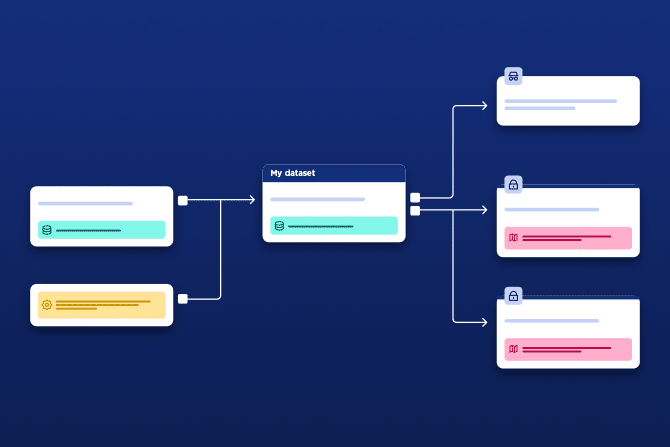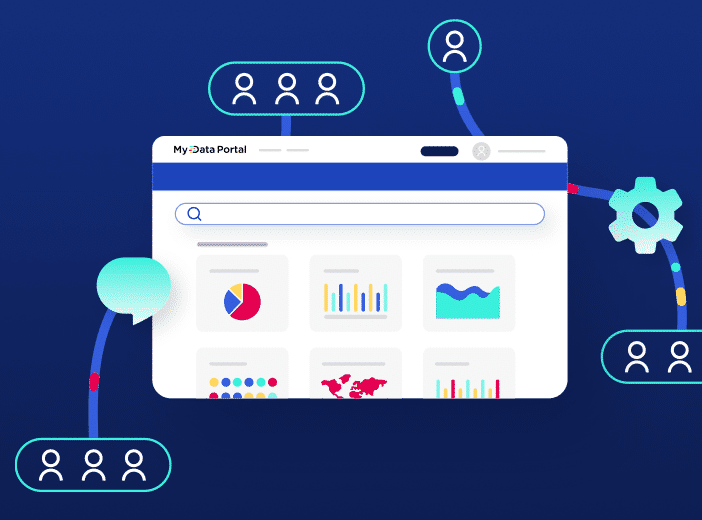Analyze your data usage with Opendatasoft’s new data lineage feature

Opendatasoft has launched its unique, innovative data lineage feature. Focused on usage, it allows organizations to better understand how their data is used internally and externally, across data ecosystems, while improving the ease and efficiency of data portal management.
Organizations in all sectors are committed to democratizing their data by creating internal data portals for employees and partners, or increasing transparency via open data portals for the general public. Focusing on data sharing leads to information being used in new, innovative ways that generates value for all.
However, understanding how data is being shared and reused is difficult with existing tools. While many solutions show the relationships between data internally within the tool, there are no solutions on the market that automatically analyze how data is being reused across your ecosystem. This prevents organizations from demonstrating how much value is being generated through data sharing while simplifying data maintenance.
That’s why Opendatasoft has launched its unique, innovative data lineage feature. Focused on usage, it allows organizations to better understand how their data is used internally and externally, across data ecosystems, while improving the ease and efficiency of data portal management.
Opendatasoft data lineage: a unique feature in the market
Opendatasoft’s product and technical teams are constantly developing new capabilities to encourage data democratization and help customers turn their data into value.
Opendatasoft’s data lineage feature has therefore been created to support customers in automating analysis of their data usage, improving governance and giving greater visibility and control.
Combining detailed mapping of the dataset journey and an in-depth dashboard, data lineage lets you track and analyze multiple indicators to understand more about how your data is being reused.
Data lineage helps organizations find answers in key areas, helping them accelerate data value. For example:
- A dataset is heavily used by lots of people: should further, similar data be published? Should it be updated more regularly?
- A dataset is not used extensively: should it be removed or should it be promoted more heavily to potential users?
- There are invalid relationships between datasets on my portal: what can I do to improve quality?
- I have an open data portal: how is usage split between internal and external visitors?
Discover Opendatasoft’s data lineage feature in our video :
Mapping the journey of your data
The data lineage feature provides detailed mapping of each and every dataset, from its creation to final destination. All of this information is easily accessible from the back office of your data portal, increasing visibility over data usage.
You can also access detailed information on the origin and reuses of your data:
- Data origin and status (valid or invalid)
- Relationship between datasets (federation or join)
- Objects used (pages, datasets, maps, geographic processors, etc.)
- Data modifications and processing that has taken place.
A dashboard to monitor your data usage
Data portal administrators also have access to a comprehensive data usage dashboard. This provides key information that enables the instant analysis of data usage, enabling better understanding and management of your overall portal.
In just one click, it enables access to KPIs such as:
- direct or invalid relationships between datasets: enabling the identification of datasets with high added value and those that need to be modified or deleted.
- the quantity of data reused by different audiences in your ecosystem, and the most popular formats they access. This enables you to better understand and meet your users’ needs.
- the proportion of external data reused on your portal.
Data lineage with Opendatasoft: feedback from our customers
Co-created with our customers, our new data lineage feature is already being used extensively, creating value for our customers and their employees, partners and external audiences.
It delivers benefits in three key areas:
Demonstrating the value your data portal delivers
Data lineage’s mapping and dashboard features offer different levels of information on data use. This helps data teams demonstrate the impact and ROI of their data portal to all stakeholders.
From a data publisher perspective, one of the problems experienced with open data is understanding what data users are doing with the data. Whilst Opendatasoft facilitates the submission of reuses already, this new data lineage feature provides additional insight into the maps and charts that users have built whilst maintaining user anonymity, that we would not have known about. This adds to the value of open data.
On the business side, the data lineage feature provides key information to demonstrate the value of open data and data sharing by easily showcasing how data has been reused. On the technical side, it is a great addition to enable more robust data governance processes.
Improving data portal maintenance
Automated documentation of data flows reduces workloads and increases team productivity. Thanks to real-time mapping of data transformations from source to reuse, organizations can more easily identify datasets that need to be maintained, deleted or modified.
The data lineage feature significantly improves the tracking and management of our internal data portal. Intuitive and easy to use, it allows us to quickly identify changes in datasets and their repercussions, thus saving us precious time. We are very satisfied with this new feature in the platform and are already looking forward to its future developments!
The lineage functionality is a useful advance for managing our data portal. It allows us to understand flows more easily thanks to a better analysis of the links between different datasets, or between datasets and pages. Our portal is growing rapidly and is managed by multiple people. Data lineage is therefore essential to control the structure of the links between the different elements of our portal.
Strengthen your data sharing strategy
Data lineage enables you to build your data sharing roadmap more confidently, based on insights into how your data is being used. You’ll benefit from a better understanding of user needs and be able to adapt your strategy and tactics based on detailed analysis. It also enables you to take advantage of opportunities within the Opendatasoft ecosystem through our dynamic community.
The use of data lineage allows us to easily visualize the relationships between different stakeholders. In an open data portal context, it is particularly useful in encouraging collaboration with other players in the Opendatasoft ecosystem. It elevates the open data approach to the next level, giving it more meaning and value. Overall, it creates new opportunities for SNCF across its ecosystem thanks to the increased visibility that the data lineage feature provides.
We use lineage to easily visualize the joins made during dataset preparation, but more importantly to identify any reuses impacted by changes to any of our datasets.
Understanding how data is being used and improving governance is key to increasing sharing and accelerating data democratization. Opendatasoft’s new data lineage feature provides organizations with greater visibility and control, helping them demonstrate value and better meet user needs inside and outside the organization.
Find out more about our data lineage functionality – click here to book an appointment to speak to one of experts today.

Data portals need to demonstrate their impact and meet user needs by providing the right data assets to generate reuse. We explore how our customers are using the Opendatasoft data lineage feature to analyze portal performance and continually improve the experience they provide.

How can you break down silos and make data available to everyone within your organization, not just data specialists? How do you get employees to use data effectively in their everyday working lives? This article explains the key features you need on your data portal to engage users and maximize data sharing and reuse.

